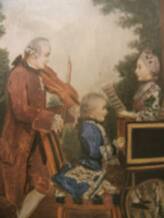




I never have really considered the link between mathematics and the arts. One frequently hears about those with a right-oriented brain being more predisposed to the artistic matters of life; whereas those who are left-brained are more geared to the sciences. I never really considered the link until I watched a youtube video entitled Donald in Mathmagic Land. That is Donald Duck. A friend from my church who recently earned his PhD at SMU sent that to me and I learned about the linkage between the Pythagorean theorem and music, architecture, the arts, the human body, games and the mind.
As it had been a few days since my high school math courses, I had to re-familiarize myself with who Pythagoras was, and re-read his theorem. Then I would attempt to understand the linkage between that and music.
Pythagoras was born in 570 BC on the island of Samos. During his early years he traveled widely throughout the Mediterranean visiting such places as Egypt, seeking knowledge. Around 530, he moved to Croton, a Greek colony in Southern Italy where he and his followers established a religious sect known as Pythagoreanism. They were active in the politics of Croton, but were driven from the city and their meeting places burned, when they were perceived as a threat. His last years were spent in Metapontum where he died in 495 BC.
Pythagoras, of course was best known for the Pythagorean Theorem which according to Wikipedia states:
“In any right triangle, the area of the square whose side is the hypotenuse (the side opposite the right angle) is equal to the sum of the areas of the squares whose sides are the two legs (the two sides that meet at a right angle).
The theorem can be written as an equation relating the lengths of the sides a, b and c, often called the Pythagorean equation:[1]
where c represents the length of the hypotenuse, and a and b represent the lengths of the other two sides.”
Going back several millennia in history, legends are sometimes more interesting than the truth. The popular story states that Pythagoras came upon some blacksmiths who were at work one day and was awed by the sounds coming from their anvils. He marveled at the beauty and harmony he was hearing and decided that the scientific law that enabled this to happen was mathematical and could be applied to music. He examined the tools of the blacksmiths and discovered that the hammers were ratios of each other with one being half the size of the first, the other two-thirds the size and the others at other ratios.
The actual truth however is that the ratios were only relevant to string length and not hammer weight. It may be that Pythagoras actually discovered the properties of string length. One day we will know for certain. At any rate, Pythagoreans did elaborate on a theory of numbers, although historians and scholars are still debating its exact meaning. Another belief that has been attributed to Pythagoras is the “harmony of the spheres”. Wikipedia defines it as:
“Musica universalis (lit. universal music, or music of the spheres) is an ancient philosophical concept that regards proportions in the movements of celestial bodies—the Sun, Moon, and planets—as a form of musica (the Medieval Latin name for music). This 'music' is not usually thought to be literally audible, but harmonic and/or mathematical and/or religious concept. The idea continued to appeal to thinkers about music until the end of the Renaissance, influencing scholars of many kinds, including humanists.”
I then progressed to thinking about which composer likely applied mathematical principles to the works that he composed. Just by chance my mind fell on Johann Sebastian Bach. I remember a Breakpoint program that Chuck Colson did on the radio on March 9, 1998 where he mentioned that Japanese students were becoming Christians through listening to music by Bach. I found that quite interesting. I always have heard the idea that listening to classical music is good for your brain. I also appreciate the cleanness of Japanese and Chinese art. It seems very structured to me. Taking the linkages and my limited knowledge, I decided to explore the music of Bach.
http://www.getintoclassical.com/composers/bach/
Johann Sebastian Bach lived from 1685 to 1750 and was a composer during the Baroque era. This era is known as a period in the arts, visual and musical, from about 1600 to 1750 which is marked by elaborate ornamentation and efforts to create dramatic effects. Elaborate ornamentation fairly well describes Bach who wrote about 1,100 compositions. His style can be described as layered, precise and mathematical. Many Bach pieces have some straightforward, layered melodies which are then re-arranged and ordered in novel and intricate ways.
Bach used a number of formal mathematical patterns in his compositions. He used the “golden section” and the “Fibonacci Succession” the latter of which is demonstrated this way (1,1,2,3,5,8,13, etc…) Each number in the succession is the sum of the two previous ones. He has been called an architect in this regard, assembling the components of a piece into one harmonious whole before initiating the composition. He believed that a well proportioned Fugue would be a sure basis for a successful composition. Numerologists appreciated this as they explored music’s ideal form.
There has been a strong theological lense applied to the examination of Bach’s works. The use of symbolic numbering has been applied to the St. Matthew Passion. Each movement in the choral Wozu Dienet has 11 beats, and the word Amen is used 11 times – some have speculated that could represent the 11 disciples of Jesus.
This interest in numerology has produced some absurd results on occasion. Bach was apparently fascinated by one particular form of symbolism in which letters and names could be expressed in numbers (A = 1, B = 2, C = 3 etc.) The sum total of the letters in the word Bach is 14, and J. S. Bach produces a figure of 41. When Bach was asked to join Die Mizlersche Societät in Leipzig, some sources claim that he waited until he could become member number 14. Furthermore, when his official portrait was being painted for the organization, he was committed to canvas with 14 clearly visible buttons on his coat.
Contributing material to this article came from “Music is Also Mathematics”, “Donald in Mathemagicland”, “Bach’s St. Matthew Passion”, and Get Into Classical – Composers - Bach
Mathematical
Music
Posted July 1, 2012 by Chuck DeShazo
